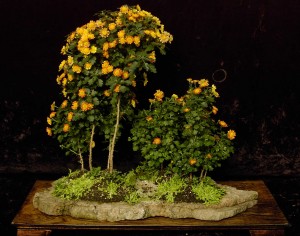Create Your Own Chrysanthemum Bonsai with a Slab Planting
Posted in Exhibitions, Kiku, Learning Experiences on October 28 2009, by Plant Talk
Follow this Step-by-Step Guide by NYBG Adult Education Instructor
 |
John Capobianco, an instructor in the Adult Education Program of The New York Botanical Garden, is a four-time national gold medal winner for chrysanthemum bonsai display. He is president of the Long Island Chrysanthemum Society, a past president of the Bonsai Society of Greater New York, and a board member of the National Chrysanthemum Society. |
 As Kiku in the Japanese Autumn Garden makes apparent, chrysanthemums are among the most versatile woody perennials around. They lend themselves to being trained into many different forms.
As Kiku in the Japanese Autumn Garden makes apparent, chrysanthemums are among the most versatile woody perennials around. They lend themselves to being trained into many different forms.
You can try your hand at chrysanthemum bonsai by creating a slab planting—an arrangement done on a relatively flat stone to depict a lone tree on a cliff or a forest on an island or whatever you may imagine.
Unlike other forms of bonsai, slab plantings start with the container, in this case a flat rock or ceramic piece. It should be oblong; one with steps, crags, or an irregular outline makes it more interesting. Stones have movement and a flow to them. Examine the stone and choose the position you wish to highlight and harmonize with the planting.
Decide on the cultivar you want to grow, and get to work making cuttings or placing an order. Plan on growing more than you will need as some will get damaged and be unusable when it comes time to assemble the planting. Expect to reject about 50 percent of what you grow. You’ll want to use an odd number for the planting group, which makes for a more stimulating design.
To grow your chrysanthemum “trees,” put plants in a few different-size containers—2½ , 3, 4, and 6 inches. Much like the myth about goldfish, the mums will only grow to the size of their environment. Those in the small containers will have less water and nutrients and so won’t grow as thick or as tall. This will ensure that your trees will be of different heights and thicknesses in the group planting.
Pinch the plants to encourage branching into a tree form. If the line of a trunk needs to be altered, you may need to wire the plant to the desired form. This takes skill. Be careful not to break branches, and don’t trap leaves under the wire. Practice on your rejects.
